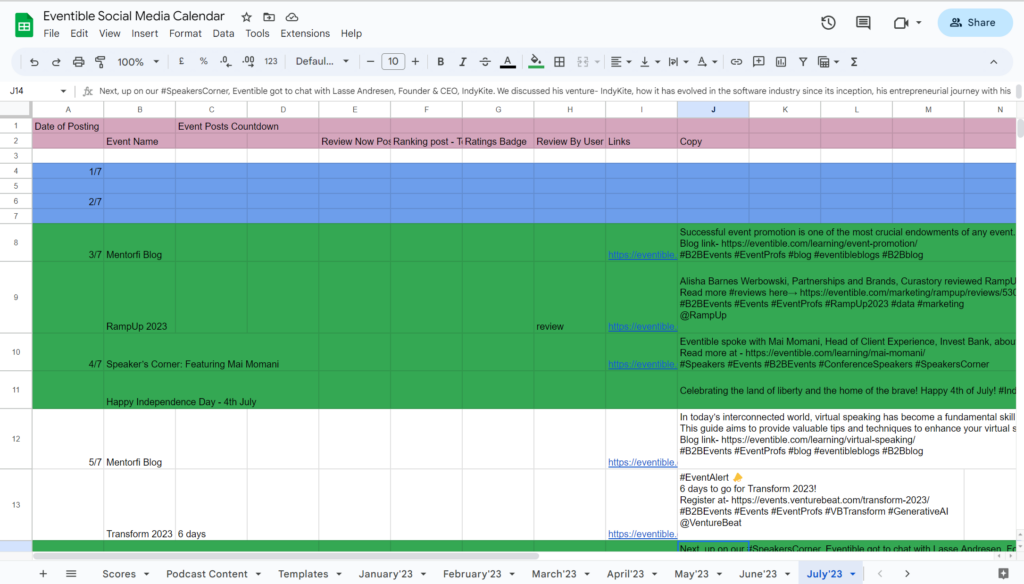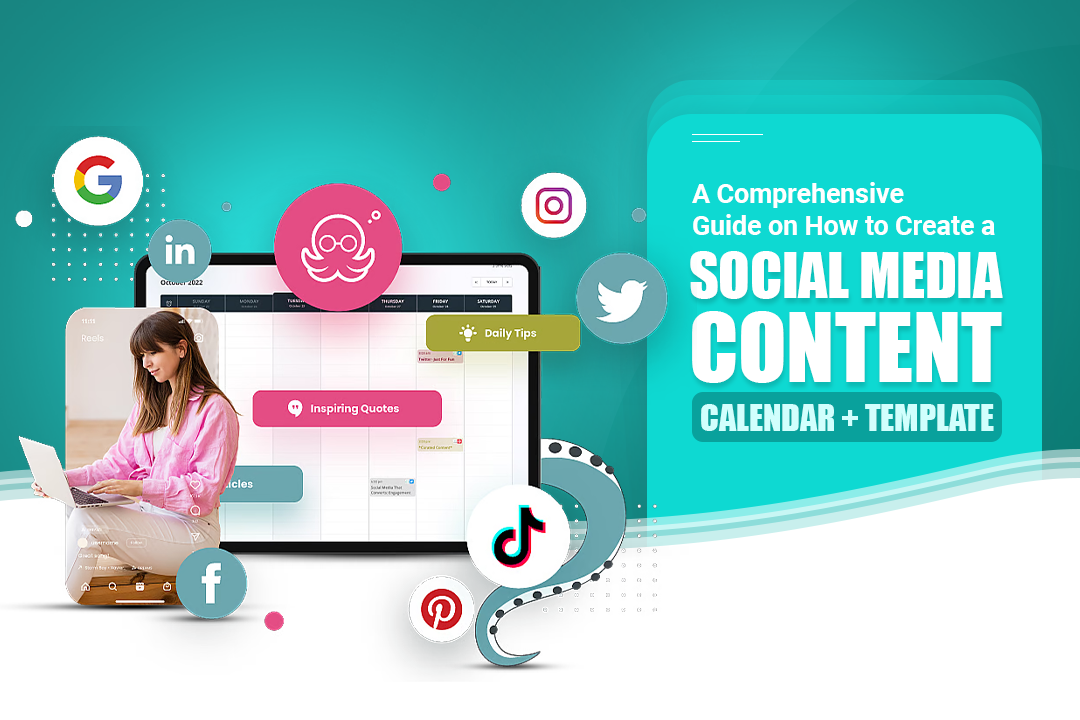Creating a social media content calendar is integral to any successful marketing strategy in today’s digital landscape. However, managing multiple platforms, staying consistent, and engaging your audience can take time and effort. That’s why we’re excited to present you with a comprehensive guide on creating a social media content calendar.
What is a Social Media Calendar?
A social media calendar is a strategic tool for planning, organizing, and scheduling content shared across various social media platforms. It is a central hub for managing and maintaining an effective social media presence for a person or company. This helps a social media marketing team schedule daily, weekly, monthly, and yearly work.

At its core, a social media calendar outlines the types of content, the posting dates and times, and the platforms on which the content will be shared. It visually represents your social media strategy and ensures your content is consistently distributed, engaging, and aligned with your overall marketing objectives.
Tips on how to create a Social Media Content Calendar
1. Defining Your Goals
- Increase brand awareness: Your goal may be to reach a wider audience, improve brand recognition, and establish a strong online presence.
- Drive website traffic: If your objective is to generate more traffic, your social media calendar should focus on promoting your website content and including compelling calls to action.
- Generate leads and conversions: You can capture leads and convert them into customers. Your social media calendar can include content encouraging users to sign up for newsletters, download resources, or participate in promotions.
- Enhance customer engagement and loyalty: Your social media calendar can include strategies to encourage interaction, respond to inquiries, and provide valuable content.
- Showcase thought leadership: If you aim to position yourself as an industry expert, your social media calendar can focus on running insightful monthly campaigns that establish your authority and expertise.
2. Knowing Your Audience
Understanding your target audience is crucial for effective social media marketing. Consider these factors when getting to know your audience:
- Demographics: Understand the age, gender, location, and other relevant demographic information of your target audience.
- Interests and preferences: Research your audience’s interests, hobbies, and likes to create content that resonates with them.
- Behavior and habits: Identify how your audience uses social media, which platforms they prefer, and when they are most active online.
- Pain points and needs: Determine your audience’s challenges, problems, or needs and tailor your published content to provide solutions and value.
3. Choosing the Right Platforms
- Audience presence: Determine which platforms your target audience uses the most and prioritize those platforms in your social media calendar.
- Platform suitability: Different platforms cater to different content formats and audiences. Choose platforms that align with your content types and communication style.

- Resources and capabilities: Assess your available resources and capabilities to effectively manage and maintain multiple social media platforms. Start with a manageable number and expand as you grow.
- Industry relevance: Research whether specific platforms are more relevant or widely used within your industry. Consider where your competitors are present and how you can differentiate yourself.
4. Establish a Content Mix
A diverse content mix is crucial for engaging your audience and social planning per their taste. Follow the steps below to do that-
- Variety is key: Include a mix of content types such as text, images, videos, infographics, curated content, and user-generated content.
- Entertaining and engaging content: Captivate your audience with humor, interactive elements, behind-the-scenes glimpses, and inspiring stories.
- Promotional content: Showcase your products, services, or special offers while balancing with other content types.
5. Plan Your Content Themes
Strategic planning of content topics ensures that your social media posts have a cohesive narrative and resonate with your audience. This can involve some manual work and regular collaboration with your social team. Take a look at the following steps-
- Identify overarching themes: Determine broad topics that align with your brand and resonate with your audience.
- Align with industry trends and events: Stay updated on industry news and events to create timely and relevant content.
- Evergreen content: Incorporate topics that have long-term relevance and can be shared consistently throughout the year.
6. Create a Posting Schedule
Maintaining a consistent posting schedule is essential for a successful social media presence. Determining the ideal posting frequency and considering optimal posting times is vital. Consider the following steps-
- Consistency is key: Maintain a regular posting schedule to build audience trust and expectation.

- Determine posting frequency: Decide how often you’ll post on each platform based on your audience’s preferences and platform algorithms.
- Consider optimal posting times: Identify the periods when your audience is most active on each platform to maximize visibility and engagement.
- Utilize scheduling tools: Use social media management tools to plan and automate your posts. This ensures a consistent presence without manual effort.
7. Incorporate Important Dates and Events
- Identify relevant dates: Determine which holidays, observances, industry events, or special occasions are pertinent to your brand and target audience.
- Research their significance: Understand these dates’ cultural or industry relevance to ensure your content resonates with your audience and reflects your brand’s values.
- Align with your brand and audience: Choose dates that align with your brand identity and are likely to interest and engage your target audience.
- Include selected dates in the calendar: Add the identified dates to your social media calendar, ensuring they are visible and easily referenced by your team.
- Plan content and use relevant hashtags: Develop ideas and themes related to the selected dates. Incorporate relevant hashtags to increase your posts’ visibility and reach in conversations around those dates or events.
8. Collaborate with Your Team
The marketing team should have a monthly view of the posting calendar to collaborate with their team effectively. Follow these steps to get fresh ideas for social media content creation:
- Gather team members: Gather relevant team members, such as marketers, designers, copywriters, and social media managers, who will contribute to the content creation process.
- Conduct brainstorming sessions: Schedule dedicated sessions where team members can share ideas, insights, and suggestions for social media content. Encourage an open and collaborative environment to foster creativity.
- Value diverse perspectives: Embrace your team’s diversity by actively encouraging and respecting different perspectives. Each team member brings unique skills and experiences that can contribute to the overall success of your social media efforts.
- Assign roles and responsibilities: Clearly define roles and responsibilities for each team member involved in the social media content creation process. Assign tasks based on individual strengths and expertise to ensure a smooth workflow.
- Align content with brand voice and messaging: During the collaborative process, ensure that the content ideas and themes align with your brand’s voice, values, and messaging. Consistency in brand identity across social media channels helps establish a solid and recognizable presence.
9. Monitor and Analyze
This step helps analyze the posting routine for different social media channels. To gain valuable insights into your social media metrics, follow these steps for effective monitoring and analysis:
- Use analytics tools: Utilize social media tools provided by the platforms or third-party tools to gather data on key metrics such as engagement, reach, click-through rates, and conversions.
- Track key metrics: Regularly monitor and track the performance of your social media content to understand what resonates with your audience and drives desired outcomes.

- Review patterns and trends: Conduct a social media audit to identify trends and insights about your audience’s preferences, peak engagement times, content types, and platforms that perform well.
- Identify successful content: Determine which content performs exceptionally well in terms of engagement metrics, reach, and conversions. Identify common elements or themes among successful posts.
- Optimize strategy based on insights: Use the insights gained from monitoring and analysis to refine your digital calendar. Adjust your content mix, posting times, messaging, or platform focus based on what the data reveals.
10. Stay Flexible and Adapt
This approach allows you to seize opportunities and maintain a strong connection with your followers. Follow the steps below-
- Plan but remain flexible: Be prepared to adapt and make changes based on social profiles, industry news, or unexpected events.
- Monitor real-time events: Stay up-to-date with real-time events, news, and conversations relevant to your industry or audience.
- Be open to spontaneous content: While having a planned content calendar, be open to seizing unexpected opportunities. This can include jumping on trending topics or capitalizing on timely events to engage your audience.
- Adjust the calendar as needed: Regularly evaluate the performance of your social media content and metrics. If certain strategies or content types are not delivering the desired results, be willing to adjust your calendar.
- Engage with the audience in real-time: Actively monitor and respond to your audience’s comments, messages, and mentions in real-time. Participate in ongoing conversations to show your audience you are actively listening and addressing their needs.
Tools to Create a Social Media Calendar
Several tools are available to streamline the creation of a social media calendar and ensure efficient planning. Here are some popular tools you can use:

- Airtable: Airtable is a flexible database and project management tool that can be adapted to create social media calendars. It provides a customizable and visually appealing interface for organizing and scheduling social media content.
These tools can streamline the creation process of your social media calendar and help you stay organized in managing your social media content.
Benefits of Creating a Social Media Calendar
Creating a social media calendar offers numerous benefits for individuals and businesses looking to establish a solid online presence. Here are some key benefits of having a social media calendar:

- Audience Engagement: By mapping out your content in advance, you can tailor your posts to engage your target audience. You can plan various content types, such as educational posts, entertaining visuals, or engaging questions, to capture your audience’s attention and interest.
- Content Cohesion: With a social media calendar, you can maintain a cohesive and consistent brand voice across all your platforms. By planning your content theme to resonate with your audience, you can ensure your posts align with your brand values.
- Adaptability: A social media calendar provides structure but allows room for flexibility and adaptability. You can easily adjust your content plan based on real-time events, industry trends, or audience feedback. This enables you to stay relevant and responsive in your social media communications.
- Collaboration: Creating a social media calendar encourages collaboration within your team. It allows team members from different departments to contribute ideas, provide feedback, and coordinate their efforts. This collaborative approach helps generate diverse content and ensures everyone is aligned with the social media strategy.
- Analytics and Optimization: A social media calendar allows you to track and analyze your posts’ performance more effectively. You can identify successful content strategies and optimize future posts for better results by monitoring metrics such as engagement, reach, and conversions.
You can effectively manage your social media presence by planning and achieving better results in your online marketing efforts.
Key Takeaway
A social media calendar is invaluable for individuals and businesses looking to improve their virtual presence. A well-crafted calendar allows you to tailor your upcoming posts to your goals and optimize your performance through data-driven insights. Investing time and effort in creating a social media content calendar lays the foundation for a successful and effective social media strategy.
Remember that it is essential to regularly review and update your social media calendar as your business evolves and trends change. Stay proactive, experiment with different approaches, and be open to adapting your strategy based on audience feedback and market dynamics. If you want inspiration for new content ideas, read our article on – B2B Social Media Content Ideas to plan your upcoming content calendar.





Comments are closed.